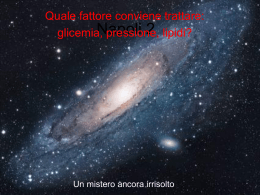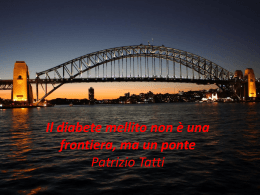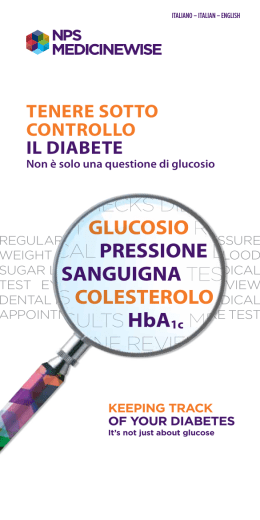Marcus Tullius Cicero (106–43 BCE) «Ipse dixit») Aristotile (384–322 BCE) «αὐτὸς ἔφα» Il controllo esagerato della glicemia e della pressione arteriosa Patrizio Tatti Inverclyde Hospital UK disclosure Negli ultimi due anni patrizio tatti ha avuto rapporti di lavoro / consulenza con i seguenti produttori di farmaci: Eli Lilly Novo Abbott Bayer Novartis Roche Merk Medtronic Non possiede azioni e non è in alcun modo shareholder di alcun produttore di farmaci Ia storia ed il mito I due studi che seguono: A-riguardano soggetti all’ esordio di malattia B-sono stati studi di intervento seguiti da studi osservazionali DCCT: Rapporto tra HbA1c e rischio di complicanze microvascolari – DMT1 15 p<0.0001 Hazard ratio 10 WOLKVAGEN Jetta 1983 WOLKVAGEN Jetta 2010 1983-1993 1 37% decrease per 1% decrement in HbA1c 0 .5 0 5 6 7 8 9 10 Updated mean HbA1c UKPDS 35. BMJ 2000; 321: 405-12 11 DCCT – Macrovascular complications I dati del DCCT sono stati impropriamente «esportati» al DMT2 UKPDS Type 2 DM– microvascular complications 1977-97 % of patients with an event 30% Conventional Intensive p=0.0099 20% 10% Risk reduction 25% (95% CI: 7 % to 40%) 0% 0 3 6 9 12 Years from randomisation 15 Ukpds Study- CHD Relative Risk & HbA1c Observational analysis Hazard ratio 5 14% decrease per 1% HbA1c decrement, p<0.0001 1 UKPDS Glucose Study showed: 16% decrease for a 0.9% HbA1c difference p=0.052 0.5 0 5 6 7 8 9 Updated mean HbA1c UKPDS 35. BMJ 2000; 321: 405-12 10 11 UKPDS: legacy effect of earlier glucose control After median 8.5 years post-trial follow-up Aggregate Endpoint Riduzione Rischio assoluto eventi /related 1000 pazienti Any3-4 diabetes endpoint anno (NNT/anno = 285) 1997 2007 RRR: P: 12% 0.029 9% 0.040 Microvascular disease RRR: P: 25% 0.0099 24% 0.001 Myocardial infarction RRR: P: 16% 0.052 15% 0.014 All-cause mortality RRR: P: 6% 0.44 13% 0.007 Legacy effect Nel periodo 1997 – 2007 state usate altre RRR =sono Relative Risk Reduction, P = medicine Log Rank che potevano avere un loro intrinseco effetto cadiovascolare T intensiva: 2729 soggetti T convenzionale: 1138 soggetti Relative Risk for CHD & Blood Pressure Observational analysis Hazard ratio 5 14% decrease per 10 mmHg SBP decrement, p<0.0001 1 UKPDS Blood Pressure Study showed: 21% decrease for a 10 mmHg SBP difference 0.5 110 120 130 140 150 160 170 Updated mean systolic blood pressure UKPDS 36. BMJ 2000; 321: 412-19 UKPDS • “This paper reports that patients with hypertension and type 2 diabetes assigned to tight control of blood pressure achieved a significant reduction in risk …(omissis)…………..The mean blood pressure over nine years was 144/82mm Hg on tight control compared with a less tight control mean of 154/87mm Hg” BMJ 1998;317(7160):703-713 • UKPDS observational study showed that “risk of diabetic complications was strongly associated with raised blood pressure. Any reduction in blood pressure is likely to reduce the risk of complications, with the lowest risk being in those with systolic blood pressure less than 120 mm Hg.” BMJ 2000;321(7258):412-419 J-curve revisited: an analysis of blood pressure and cardiovascular events in the Treating to New Targets (TNT) Trial European Heart Journal (2010) 31, 2897–2908 doi:10.1093/eurheartj/ehq328 ACCORD ADVANCE VADT No. of participants 10,251 11,140 1791 Participant age,years 62 66 60 Participants – male, % 62 58 97 Duration of DM at entry, years 10 8 11.5 A1C at Baseline, % 8.1 7.2 9.4 Participants with prior CV event, % 35 32 40 Duration of follow-up, years 3.4 5.0 6 Statistical difference between groups (P ≤ 0.05) Outcomes, intensive vs. standard ACCORD ADVANCE A1C, % 6.4 vs. 7.5* 6.4 vs. 7.0* 6.9 vs. 8.4* Death from any cause, % 5.0 vs. 4.0* 8.9 vs. 9.6 NA Death from CV event, % Nonfatal MI, % 2.6 vs. 1.8* 4.5 vs. 5.2 2.1 vs. 1.7 3.6 vs. 4.6* 2.7 i vs. 2.8 6.1 vs. 6.3 10.5 vs. 3.5* 2.7 vs. 1.5* 21.1 vs. 9.7* 3.5 vs. 0.4* 0.0 vs. -1.0* NA Major/severe hypoglycemia, % Weight gain, kg Statistical difference between groups (P ≤ 0.05) VADT 34533 soggetti, 18315 t. intensiva; 16281 t standard Mortalità per tutte le cause Mortalità CV Metanalysis: intensive glucose control in T2DM Turnbull FM et Al Diabetologia (2009)52:2288-98 Figure 1 Diabetes Care, Diabetologia. 19 April 2012 [Epub ahead of print] (Adapted with permission from: Ismail-Beigi F, et al. Ann Intern Med 2011;154:554) Accord Blood Pressure Primary & Secondary Outcomes Intensive Standard Events (%/yr) Events (%/yr) Primary HR (95% CI) P 208 (1.87) 237 (2.09) 0.88 (0.73-1.06) 0.20 Total Mortality 150 (1.28) 144 (1.19) 1.07 (0.85-1.35) 0.55 Cardiovascular Deaths 60 (0.52) 58 (0.49) 1.06 (0.74-1.52) 0.74 Nonfatal MI 126 (1.13) 146 (1.28) 0.87 (0.68-1.10) 0.25 Nonfatal Stroke 34 (0.30) 55 (0.47) 0.63 (0.41-0.96) 0.03 Total Stroke 36 (0.32) 62 (0.53) 0.59 (0.39-0.89) 0.01 Also examined Fatal/Nonfatal HF (HR=0.94, p=0.67), a composite of fatal coronary events, nonfatal MI and unstable angina (HR=0.94, p=0.50) and a composite of the primary outcome, revascularization and unstable angina (HR=0.95, p=0.40) Mean # Meds Intensive: Standard: 3.2 1.9 3.4 2.1 3.5 2.2 3.4 2.3 Average after 1st year: 133.5 Standard vs. 119.3 Intensive, Delta = 14.2 * * * * Rapporti epidemiologici ed interventistici tra Colesterolo, Pressione arteriosa, HbA1c e malattia CV Variabile IMA fatale+ nonfatale +morte improvvisa Ictus (tutti) Malattia CV Colesterolo (1mmol/l) • Dati Epidemiologici (%) -30 -10 • Studi intervento (%) -23 -17 • NNT per 5 aa 59.2 177.7 44.4 Pressione arteriosa (10/5 mmHg) • Dati Epidemiologici (%) -25 -36 • Studi intervento (%) -22 -41 • NNT per 5 aa 61.8 73.7 33.6 Glicemia (HbA1c 0.9%; 10 mmol) • Dati Epidemiologici (%) -12 -15 • Studi intervento (%) -9.7 -4.0 • NNT per 5 aa 140.3 767.7 118.5 J. S. Yudkin & B. Richter & E. A. M. Gale. Intensified glucose lowering in type 2 diabetes: time for a reappraisal. Diabetologia (2010) 53:2079–2085 • Non esiste prova definitiva che riducendo indiscriminatamente la glicemia e la HbA1c si stia riducendo il danno CV. Anzi si potrebbe aumentare la mortalità • Non esiste prova che riducendo la PA al di sotto di 140/80 mmHg si stia riducendo il danno CV. Anzi si potrebbe aumentare la mortalità • La miglior dote del medico rimane il buon senso, non le linee guida Cu' tanta galle a canta', nun fa' maje juorno.
Scarica




